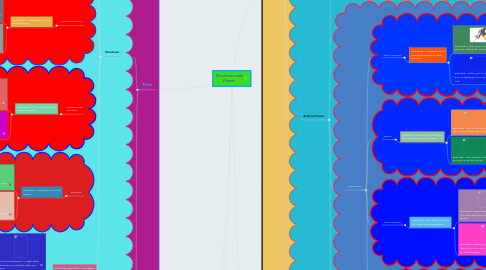
1. Form
1.1. Structures
1.1.1. Shell Structure
1.1.1.1. Definition: A structure that is hollow inside.
1.1.1.1.1. Example: An egg because the inside is just a yolk surrounded by a thin shell
1.1.1.1.2. Example: A helmet because it's empty on the inside and the outside is a hard piece of plastic.
1.1.2. Solid Structure
1.1.2.1. Definition: A structure that is solid mostly through the structure.
1.1.2.1.1. Example: An eraser because it is as big piece of rubber which no holes on the inside.
1.1.2.1.2. Example: A sandcastle because even though there might be a few holes its solid most of the way through.
1.1.3. Frame Structure
1.1.3.1. Definition: A structure that has joined pieces.
1.1.3.1.1. Example: A spider web because they are made of pieces of joined silk
1.1.3.1.2. Example: A bicycle because the wheel, handles etc are all joined together.
1.1.4. Combination Structure
1.1.4.1. Definition: A structure made of many materials.
1.1.4.1.1. Example: A House because they are made of wood, bricks, cement, glass etc
1.1.4.1.2. Example: A car because they are made of metal, leather, rubber, glass.
1.1.5. Function
1.1.5.1. Definition: The purpose of an object
1.1.5.1.1. Examples: A boats function is to carry people across water.
1.1.5.1.2. Example: A clocks function is to tell time.
1.1.6. Structure Definition: Any object that serves a function.
1.1.6.1. Structure Example: A Light bulb because it is used to light up a room.
1.1.6.2. Structures Example: A bridge because it's used to transport vehicles across water.
1.2. Form Definition: The basic shape of a structure
1.2.1. Form Example: Fridges because you can tell that the basic shape is a rectangle
1.2.2. Form Example: Mountains because the basic shape of a mountain is a triangle
2. Sensor
2.1. Definition: A device that detects or measures conditions
2.1.1. Example: A Radar Gun because they are used to measure the speed of vehicles.
2.1.2. Example: Smoke detector because they are used to detect if there is smoke inside of a building.
3. Strength
3.1. Definition: The capability of a structure to tolerate forces
3.1.1. Example: A Bridge has the strength to handle compression because when vehicles are on a bridge it creates compression on the bridge.
3.1.2. Example: Elevators have the strength to handle when people or objects are on the elevator which creates compression.
4. Force
4.1. Internal Forces
4.1.1. Internal Force Definition: When force at one part of a structure spreads to a different part in the structure.
4.1.1.1. Compression
4.1.1.1.1. Definition: A force that squeezes or presses something together
4.1.1.2. Torsion
4.1.1.2.1. Definition: A force which twists.
4.1.1.3. Tension
4.1.1.3.1. Definition: A force that stretches apart.
4.1.1.4. Shear
4.1.1.4.1. Definition: A force that pushes in opposite directions or bends.
4.2. External Forces
4.2.1. Gravity
4.2.1.1. Center Of Gravity
4.2.1.1.1. Center Of Gravity Definition: Where most of the weight is in an object.
4.2.1.2. Gravity Definition: An invisible force that pulls down
4.2.1.2.1. Gravity Example: If you flip a cup with water over gravity acts on the water so the water would spill out of the cup.
4.2.1.2.2. Gravity Example: When you jump gravity acts on your body and you will come back down.
4.2.1.3. How To Make Structures Stable: Making the bottom heavier lowers the center of gravity which will prevent the chances of the structure falling. A wider base helps because the weight of the structure is spread out and keeps the structure balanced. If the structure is symmetrical then the structure would be more balanced and won't tip over easily.
4.2.2. Application
4.2.2.1. Point of Application
4.2.2.1.1. Definition: The point of an object where the force is applied.
4.2.2.2. Direction
4.2.2.2.1. Definition: If the force acting on the object is a push or pull.
4.2.2.3. Plane of Application
4.2.2.3.1. Definition: The angle in which the force is being applied.
4.2.2.4. Magnitude
4.2.2.4.1. Definition: The amount of force applied to an object.
4.2.3. External Forces Definition: A force that occurs outside an object
4.2.3.1. External Forces Example: Friction because it gets created on the outside of an object then it could affect the object.
4.2.3.2. External Forces Example: Gravity because it doesn't occur inside of an object but it affects objects
4.3. Force Definition: A physical action or movement.
4.3.1. Force Example: Push because you use this action to open the door, move things out of the way etc.
4.3.2. Force Example: Pull because this action is used to open doors or close doors and move objects towards you.
5. Loads
5.1. Static Loads
5.1.1. Live Load
5.1.1.1. Definition: The people or goods in/on an structure
5.1.1.1.1. Examples: Apples in a bag because the bag is the structure and the apples are the goods on a structure.
5.1.1.1.2. Example: A person on a bike because the bike is the structure and the person is on the structure.
5.1.2. Dead Load
5.1.2.1. Definition: The structure itself
5.1.2.1.1. Example: A bridges dead load is the bridge itself. (Wood, Metal etc.)
5.1.2.1.2. Example: A bikes dead load is the bike itself so it would be the rubber, metal etc
5.1.3. Static Load Definition: The effect of gravity on an object or structure.
5.1.3.1. Static Load Examples: The roof of a house pushes against the walls because gravity is causing the roof to push on the walls.
5.1.3.2. Static Load Example: A person holding a stack of books because gravity is being applied to the books so that they stay on the persons hands.
5.2. Dynamic Load
5.2.1. Definition: Any external force that isn't gravity
5.2.1.1. Example: Rain because it's not movable and it occurs outside of structures and it isn't gravity.
5.2.1.2. Examples: Wind because it isn't gravity and it occurs outside of a building and you aren't able to move the wind
5.3. Load Definition: An object that gets carried
5.3.1. Load Example: Batteries because they are an physcial object that can be carried
5.3.2. Load Example: Apples because they are an object that can be carried.

